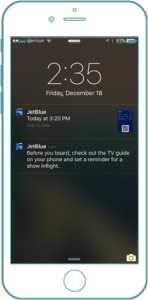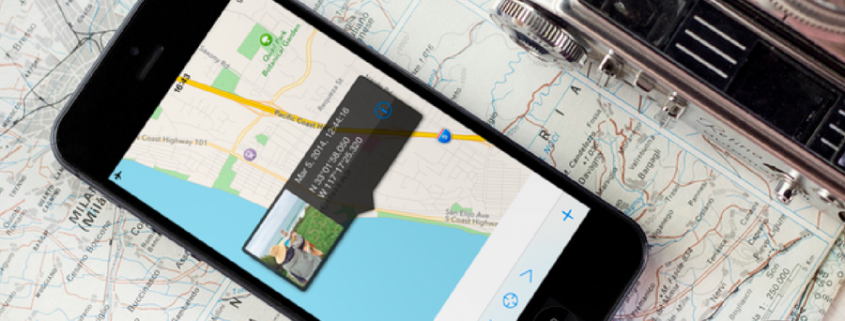5 Practical Ways to Enhance Mobile Customer Experience with Geolocation
The other day I was invited by CMOAustralia to comment on one of the common pitfalls marketers fall into when implementing location based marketing strategies; not ensuring accuracy.
Using geolocation data to engage with customers at specific locations has the power to truly enhance the customer experience.
With new technologies such as Bluedot Innovation, it is now possible to get extremely specific in terms of targeted location (almost down to the centimetre), customer and context.
When marketers fail to:
- Understand the accuracy of the method used to collect the location data
- Accurately anticipate the content/action that will enhance the customer experience,
..location-based initiatives can quickly turn into a disaster and result in a degradation of the experience instead.
“[Bluedot] has achieved accuracy of down to five meters, compared with the next closest competitor that only has accuracy down to 100 meters.” Forbes
Delivering content that is based on a specific location (down to a few meters), without the supporting backend technology, would result in irrelevant content being delivered to the targeted customer.
Similarly, content delivered successfully based on a specific location, but in the wrong context, becomes equally irrelevant.
Imagine you receive a push notification when you walk past your favorite store at 8pm (when the store has closed for the day), with a coupon to redeem the same day. Not very helpful, right?
This would rather have a negative impact on the relationship with customers.
However, when executed correctly, geolocation data enables marketers to deeply engage with mobile customers, deliver an exceptional experience, and just outright delight them.
And, as customer experience is becoming more and more important as a point of brand differentiation, I thought I’d share 5 practical and relevant ways one could go about doing so.
1. Provide content when it matters most

The key to providing content when it matters is to identify what content is needed at which touchpoints in the customer journey.
This is crucial in order to implement a geolocation strategy that truly adds value.
Marketers who have a solid understanding of their customer’s interaction with various physical touchpoints will be able to anticipate what content the customer is likely to need at each of these.
Practical Application
For example, imagine the below scenarios;
Scenario 1
Picture yourself on the way to the airport for a business trip.
- Traffic on the way to the airport is quite slow, and you are starting to get a bit stressed. You arrive at the airport, with only 10 minutes to go until check in closes.
- You rush across the airport to get to the check in counter, and as you approach the desk you realise that you forgot your ticket at home!
- You remember that at some point, you got the ticket emailed to you, so you frantically start to search for the ticket in your inbox. What email address was it sent from again? What date was it?
You finally manage to find your e-ticket, 5 minutes after the check in desk has closed…
Scenario 2
You arrive at the airport with only 10 minutes until check in closes.
- When you step out of the car, you receive a notification on your phone with your e-ticket.
- You walk up to the check in counter and check in to the flight.
- When you approach security, another notification pops up and your boarding pass appears on the screen.
- You find your gate and sit down waiting to board the plane when another notification pops up. This time with the full selection of on-flight entertainment, so that you can spend the waiting time planning what movie to watch during the flight.
Clearly the second scenario offers a much more engaging customer experience.
In this example, the brand has successfully anticipated the content that would be consumed at each physical touchpoint of the customer journey, and used geolocation technology to deliver that content.
JetBlue, an airline company based in the United States, does this quite well and are receiving fantastic customer reviews (above 4.2% average on both major app stores).
The vast majority of the feedback is centered on the user’s overall customer experience with the brand, and how easy it is to fly with JetBlue.
2. Provide content where it matters most
One of the most common applications of location-based technologies is to send customers promotions when they are in the area surrounding your business.
A recent Outdoor Media Association (OMA) report found that consumers are twice as alert and likely to act on promotional messaging when they are outside the home.
Doing so has proven successful in driving foot traffic to bricks and mortar locations.
However, it is crucial to understand the importance of personalisation when it comes to this type of triggered content.
Practical Application
Let’s say for example that I was to receive a push notification when walking past a supermarket on my way home from the office, drawing my attention to a current special on beef mince.
This would be completely irrelevant to me.
“Why?”
The location is right, I am walking past the shop.
The timing is right, I usually prefer to do my shopping on my way home.
The content though, is way off! As I am a vegan, I would never enter the store to buy a pack of beef mince.
This would of course have been reflected in my purchase history. Failing to personalise this content would certainly have a negative impact on my experience with the brand.
A real life example of a location based promotional campaign is Meat Pack’s “Hijack”, which I wrote about a few months ago.
In this creative campaign, the sneaker retail chain “hijacked” the official stores of brands sold in it’s stores, and offered a discount at Meat Pack to customers who were about to enter the competitor’s store.
As the discount fell by 1% for every second that went by, the promotion actually saw customers running across shopping malls in order to beat the clock!
For a more detailed case study, feel free to head over here.
3. Get feedback when it’s still fresh

As most businesses still struggle to make data-driven decisions, collecting, analysing and acting on customer feedback will put you a step ahead.
More than 70% of businesses that had implemented data-driven decision making reported improved financial performance in a recent Harvard Business Review study.
However, it’s difficult for customers to provide accurate feedback when they don’t have the experience fresh in their memory.
To combat this, marketers can make use of geofences (which essentially put virtual fences around specific areas) to trigger different actions, such as customer feedback surveys.
The power of this is that you can base these actions on someone;
- entering the area,
- exiting the area,
- remaining within the area for a certain period of time, or
- entering the area multiple times.
You are also able to base the triggered actions on the information we already know about this particular user, such as;
- Demographics
- Purchase/Attendance history
- Level of engagement with in-app content
This will ensure we are asking for feedback from the right customer segment, and at a relevant time.
Practical Application:
Let’s say you are hosting a comedy show, and you are looking to get feedback from attendees.
With an active geofence around the comedy venue, you would be able to ask for feedback the moment the attendee leaves the event and is likely to remember the exact experience.
You can even base the feedback questions on the time they left the show, having different questions for those who left the show early.
Or you could base the questions on their user profile, asking different questions to customers who engages with your content on a regular basis vs those who do not.
This way, you would be able to generate more meaningful feedback data, and start making data-driven decisions instead of assumptions.
4. Automatic, location-based payments
When using geofencing technology to trigger location actions, you are able to have different actions based on customers entering or exiting the “fenced” area.
Combining this technology with beacon technology and digital payment platforms opens up even further opportunities to enhance customer experience.
See also: 5 Powerful Australian Examples Of Beacon Technology In App Development
Practical Application
Imagine you decide to go down to your favourite local bar.
You enter the venue, and a geofence triggers a tab to be set up for you.
You sit down at a table and start browsing through the menu in your app.
You decide what you would like to order, and add it to your tab.
The nearby beacon knows which table you are sitting at, and adds this to the docket that gets sent to the bar/kitchen so the employees knows where to bring your order.
When you have finished your meal, you stand up, and walk out of the venue.
The geofence knows that you have exited the venue and automatically debits your card, that previously has been stored in the a payment platform (like Stripe or PayPal).
5. Engage and delight customers with location based interactions
With average retention rate for a mobile application only being 39% after only one month, it is important to keep your users engaged with fresh and relevant content.
Location based, interactive content is a brilliant way of achieving above average retention rates, and allow users to engage with your brand on a deeper level.
Practical Application:
Virgin Mobile did this very well when they launched ‘Game of Phones’ in 2013.
This engaging mobile campaign made use of location data and in-app messaging to get users to chase down and collect hundreds of different prizes with a combined value of $200,000.
Players could protect their collected prizes for up to two hours, by entering a geofenced ‘safe zone’ (which just happened to be a Virgin Mobile store).
This resulted in over 40,000 users actively engaging with the app, generating 2.5 million screen views and 14,500 visits to the different stores in a period of only 3 weeks!
Key Takeaways
Ultimately, the use of geolocation technology must be deeply integrated into the customer experience. Therefore, it is essential that we as marketers always focus on the customer, and how we can add value along the journey.
When implementing geolocation strategies is important to identify what content customers need at each step of the journey to move smoothly through to the next touchpoint. Once this has been identified and mapped out, it is best practice to start small and take an agile “build, measure, update” approach, as always is the case with new technology.
This will ensure new features are added with the customer’s experience at the core.
Latest posts by Logan Merrick (see all)
- Ep 18: Collective Campus’ CEO on Intrapreneurship and Corporate Innovation - December 20, 2016
- 50 User Engagement Strategies For Planning Memorable Mobile Experiences - December 19, 2016
- Latest Data: App Monetisation Trends And Drivers 2015-2020 - November 25, 2016




